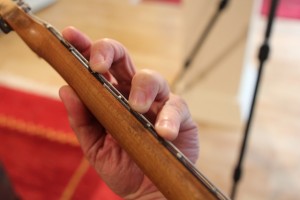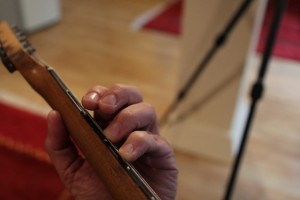In Part 1 of this series, I introduced 24 fingering patterns that can be jumping-off points to any number of warmup and dexterity-development exercises. As threatened, this installment introduces additional technical hurdles guaranteed to challenge even advanced players. Try these out—but only after you can play the everything in Part 1 comfortably and consistently (“like identical pearls on a string”).
The fret-gap variations. Try the same patterns, but with your first string on the first fret, your second string on the third fret, your third finger on the fourth fret, and your fourth finger on the sixth fret. Unless you hands are uncommonly large, you probably won’t be able to keep your hand “parked” in position as you might when playing on four adjacent frets. Just center your hand over your middle fingers, slipping slightly out of position to grab the outermost notes.
Next try the “Spock” variation, with the two-fret gap between the second and third fingers. Then the “pinky shredder,” with a two-fret gap between the third and fourth fingers. And finally, the “double gap,” with your first finger on the first fret, your second finger on the third fret, your third finger on the fourth fret, and your fourth finger on the sixth fret.
Remember, if this stretch is just too vast, start up higher on the neck where the frets are more closely spaced, and then work down to successively lower frets.
The single-string variations. Play each pattern on a single-string, but change position every four notes: For example, play 1, 2, 3, 4 on the lowest four frets, and then, without breaking tempo, repeat them on frets five through eight, then nine through twelve, and so on. See if you can make the notes before and after each jump sound as smooth as if they’d been played in position.
Hint: Think about shifting your free fingers to the new position before you’ve completed the pattern. For example, if you’re playing the 1, 2, 3, 4 pattern, your first finger can start moving toward a higher fret while you play the final note with your fourth finger, like so:
The string-jump variations. Play the patterns only on the sixth, fourth, and second strings, making sure that your transition from string to string is just a smooth-sounding as if you were moving to an adjacent string. Then try it on the first, third, and fifth strings.
The early-bird variations. Work through the 24 patterns, only transition from string to string on the fourth note of each rather than the first. For example, you’d play finger 1, 2, and 3 on the sixth string, then play the finger 4 note on the fifth string. Then try the transitioning on the third note of each pattern, then the second.
You should feel some burn, but not actual pain. Take frequent breaks, and if your fretting hands starts to seriously hurt, stop! Never, ever try to “play through” pain.











Thanks, Joe! I don’t think I’ve ever had my hand give out from playing before, that “double gap” is nearly impossible on the first fret!
Yeah, I can’t quite reach it either. But regardless of hand size, I’d suggest practicing five-fret spans this way: Situate your fretting hand so that the gap between your second and third fingers is centered over the third of the five frets. Then just pivot a bit to the left or right as needed without straying too far from that default position.
OMG I can see Crippling Carpel-Tunnel syndrome if ya do not warm up and pay close attention to the feedback you will receive if ya are doing it in a way that may damage anything LOL. I have one heck of a time getting a fret between fingers 2 and 3. Whats actually sad is I was once told by a supposed guitar instructor that there was no need to work on being able to get a fret space between fingers 2 and 3.
This is so awesome i have been debating how I would advance from what I have been using. This is a perfect bext step towards ultimate flexability and coordination thanks.
I forgot to put in there I was making a joke about the crippling Issue, As with any exercise that has suce intense stretching and so on you must always pay attention to any signs you are over doing it, but I see a many more pro’s then con’s in this exercise, I just don’t want anyone to feel this is not a safe exercise so I wanted to make sure i added this.
Well, it’s probably more a question of maximum efficiency of movement than actually transforming the physiology of the hand. When a stretch isn’t quite possible, a good technique is to center your fretting hand over the midpoint of the stretch, and then “cheat” a bit by shifting slightly to the left or right. As opposed to anchoring your hand near the lower destination and lunging awkwardly to grab the high notes.
Great post! My first guitar teacher showed me this same concept in the 70’s. His take on it was how long will it take you to go through all permutations on all 6 strings until you had covered the entire neck stepwise between frets 1 and 12 after which you descended stepwise back to the series you began with. He offered that, with patience and a sensible approach (stopping when the hand became fatigued or “sore” even if those breaks were for hours/days/weeks), the entire series could eventually be completed within 1 hour or less. My personal best was 42 minutes and it took ages to arrive at that point. I’ve never tried it since. Two variations that I do practice are playing the permutations using 4 note scales on one string and, secondly, playing 4 notes on the diagonal starting with the first finger or the fourth finger within a four fret span. However you use permutations, it’s a great base for concocting exercises that address specific areas of your personal technique that need some work.
Great stuff as always Joe!
People reading this might find this variation interesting as well. It works off of displacing 2 notes of the 1-2-3-4 by octaves.
https://www.guitar-muse.com/playing-with-spiders-or-getting-more-from-the-1-2-3-4-3324
In a shameless self promotion – I should also mention I have a book out now that covers variations of the 1-2-3-4 exercise as a method for exploring harmonic and melodic resources in a given position. (The GuitArchitect’s Positional Exploration). It’s over 200+ pages of melodic, harmonic, rhythmic and picking variations.
https://www.lulu.com/spotlight/guitarchitecture
To go along with your single string variation (jumping to the 5th and 9th frets), my classical teacher had me work patterns starting on the 1st fret, jump to 2nd, back to 1st, jump to 3rd, back to 1st, jump to 4th, etc. It really is a challenge to make those kinds of shifts seamless, but something you do a lot in classical pieces.
So this is a very late comment on this article – but I like these exercises and wanted to chime in. I will say that the second paragraph beginning with “The fret gap variations . . . ” is pretty confusing. I think the words “string” and “finger” are being interchanged a bit? There also seems to be an extra finger included (fifth finger? sixth fret?) I got a laugh out of it, but I’m honestly not sure how this first exercise differs from the double-gap exercise, because I’m not sure if I’m “interpreting” correctly. Great exercises nonetheless! Maybe you can clarify what you mean for that first one.
Hehe. Never too late to catch a type, Brian! I changed a word in paragraph 2 that should make the intended meaning clearer. 🙂